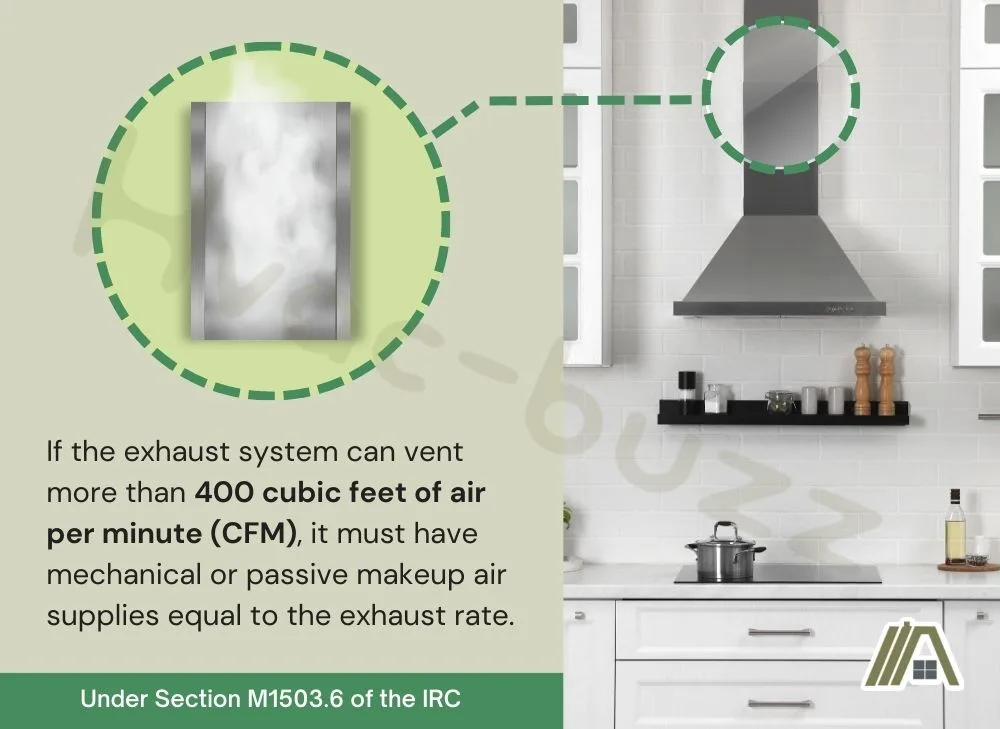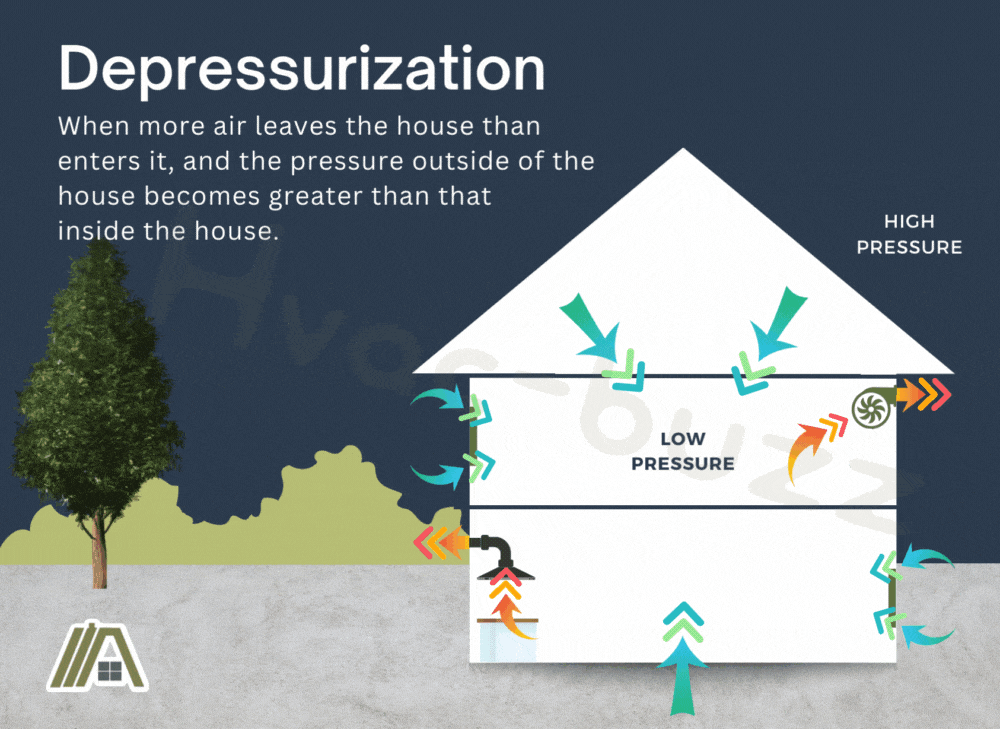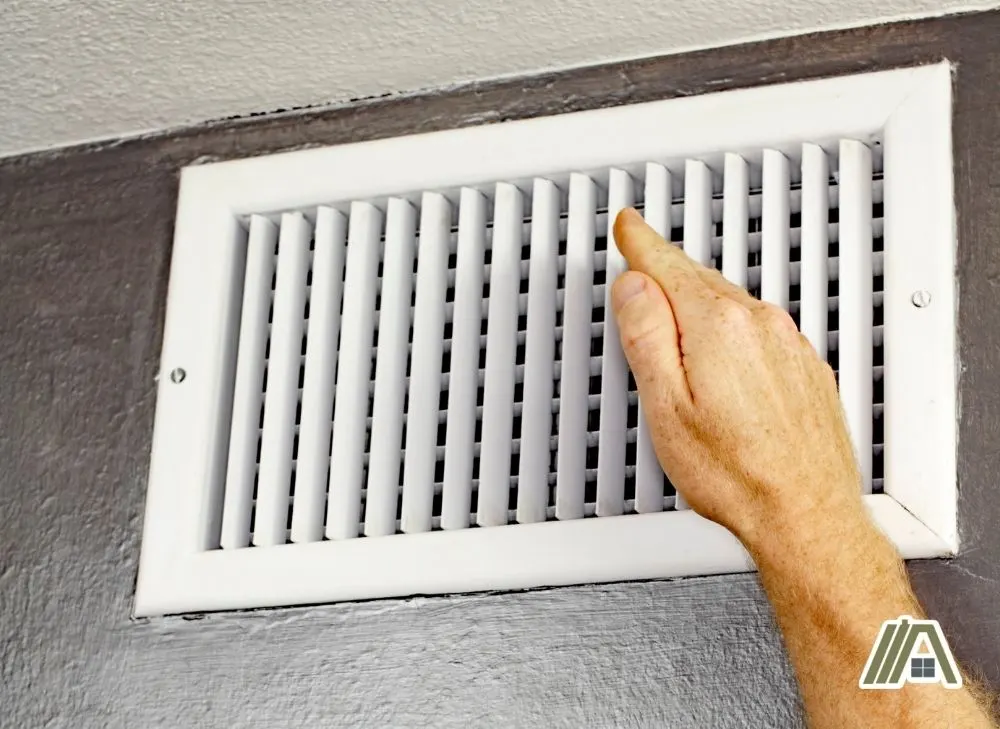Makeup air can be a little intimidating when trying to figure out what size duct you need. Especially since correct ducting is essential to the operation of your HVAC system, so you really don’t want to mess it up.
Believe me, it was a topic I avoided for a while, worrying I was in over my head. Thankfully, while it looks a bit complicated, it’s easier to understand than you think. Plus, with the information below, you will have a guide to figuring out the duct size you need with half the effort.

The size of a makeup air duct is not specified by the IRC, but the total air supplied must equal the exhaust rate in the space to prevent problems. This is established by measuring the air infiltration (using a blower door test) and exhaust rate to estimate the diameter needed.
What Does the Code Say?
Doesn’t Specify Makeup Air Duct Diameter
The International Residential Code (IRC) provides minimal information when it comes to makeup air units and their requirements. One of the things that aren’t detailed in the code is a specific duct diameter for these units.
IRC Specifies Inflow Rate
Section M1503.6 of the IRC covers the inflow rate of makeup air for range hoods: if the exhaust system can vent more than 400 cubic feet of air per minute (CFM) must have mechanical or passive makeup air supplies equal to the exhaust rate.

As plainly as possible, this means that when your kitchen exhaust system removes over 400 CFM, you need a makeup air supply to equal it.
The section addresses domestic kitchen exhaust makeup air, but logically, the principle of matching inflow rate will be the same throughout the house.
This is because makeup air is provided to eliminate problems like incomplete combustion, carbon monoxide leaks, sewer gases being pulled from drains, and ineffective exhausting of steam, smoke, and other pollutants.
All these problems are the result of negative air pressure, which is created by removing air from the room without replacing it.
Balance is Key
Balance is also key when providing makeup air.
On the one hand, replacing half of the air will not be sufficient.
On the other hand, adding too much air will create a different set of issues involving air pressure that can make space near the exhaust system compete for the air that is supposed to be exhausted.
Adding too much air in the room can actually pull air away from or overwhelm the exhaust system, meaning that the smoky kitchen will stay that way.
Determining the Correct Duct Size
When you are trying to figure out what size duct to get, you need to know the following:
- How airtight the house is
- What the infiltration rate is
- What the exhaust rate is
- The amount of makeup air required
How Airtight is the House?
To determine how airtight your home is, you will need to have a professional HVAC specialist come in to measure this. They will furnish you with a reading of CFM at 50 Pa (Pascal, the unit for air pressure).
To give you a CFM at 50 Pa, the professional will likely perform the blower door test. This test for airtightness looks at how much air gets in and out of your home.
How It Works
The name makes more sense when you understand that a blower door is a frame that is mounted in the door frame for an external door, with a fan that attaches to this. This is used to pull air from inside the house, creating low air pressure within.
When there is a low/negative pressure system, outside air (high/positive pressure system) will be pulled through the gaps and openings in your house to balance out the air pressure. This is depressurization.

Note: this can also be done in reverse, increasing the pressure indoors, if the situation requires it.
While this is happening, the specialist will use a tool (UV camera or smoke pencil) to locate the leaks, which are recorded. With this data, the specialist can quantify the air infiltration, which shows the airtightness (movement of air through the thermal envelope).
What is the Infiltration Rate?
Air infiltration refers to air moving into a building, in this case, your home.
The infiltration rate is the amount of air that moves into your home without you deliberately bringing it in.
In the context of makeup air, we need to know how much air is getting into your home naturally to figure out how much air needs to be added mechanically to compensate for the exhaust rate.
If your exhaust system is rated 400 CFM and you install a makeup air unit that pulls in 400 CFM, you will have too much air entering the house because this 400 CFM makeup air inflow will be in addition to infiltration.
Similarly, if you assume that you have a good natural infiltration rate without actually measuring it and you only bring in 200 CFM of makeup air, you might still have a negative system indoors.
As I say, you don’t want to bring in too little or too much air, as this leads to several problems involving energy usage, drafts, odors, condensation, pests, and contaminants within your thermal envelope.
| Blower Door Readings (CFM at 50 Pa) | Infiltration Rate with 1 Pa differential | Infiltration Rate with 2 Pa differential | Infiltration Rate with 3 Pa differential |
| 1000 | ±90 CFM | ±120 CFM | ±160 CFM |
| 1500 | ±110 CFM | ±190 CFM | ±250 CFM |
| 2000 | ±160 CFM | ±250 CFM | ±310 CFM |
| 2500 | ±200 CFM | ±310 CFM | ±400 CFM |
| 3000 | ±240 CFM | ±380 CFM | ±490 CFM |
| 3500 | ±290 CFM | ±420 CFM | ±580 CFM |
| 4000 | ±310 CFM | ±500 CFM | ±650 CFM |
| 4500 | ±360 CFM | ±560 CFM | ±710 CFM |
| 5000 | ±400 CFM | ±610 CFM | ±800 CFM |
The pressure differentials in the table refer to the pressure difference at the opening into the house.
You should aim to keep the differential below 3 Pa, or else you can risk backdrafting from your gas appliances and openings like fireplaces from depressurization. This is why there are no differentials higher than 3 Pa in the table.
Determining the Flow Rate of the Exhaust System
First, the system’s CFM is likely listed in online/in-store product information (for ducted range hoods). Otherwise, you might locate it in the user manual (it should be available online) or the product label on your appliance.
Alternatively, use a formula to find out the CFM rate needed for the room and base your estimation of the appliance’s capacity on that (hopefully, it’s correctly sized!).
To start, you need to know the volume of your room:
Volume of room (ft3) = length x width of floor x height of ceiling
With this information, you can use two different methods:
CFM = Volume of room/4
OR
CFM = (Volume of room x 15 air changes per hour (ACH))/60
So, if you have a 10’x12’ floor area with a ceiling height of 8.5’, your room is 1020 ft3. Both methods give you 255 CFM. So, your fan is likely a similar rate.
Required Makeup Air Inflow Rate
Now, you need to do a quick calculation. Your makeup airflow rate should be the CFM of the exhaust system, less the infiltration rate (you will need help measuring this).
Makeup air rate = exhaust system CFM – infiltration rate
Once you have established the makeup air rate needed, you can start looking at what duct size will provide this.
Since you need to specifically provide makeup air when your exhaust system exceeds (1) 400 CFM for a range hood and (2) 200 CFM for a dryer, let’s look at these figures as an example.
(In other cases, it may simply depend on the presence of a negative effect of the system on the pressure in the house, regardless of what the exact CFM is).
Say the house has a reading of 1500 CFM at 50 Pa, using the table above, we can see that the infiltration rate would be approximately 190 CFM at a 2 Pa differential.
Now, we can use the previous equation to calculate the makeup air rate for kitchens and dryers under these conditions.
(1) 400 – 190 = 210 CFM of makeup air
(2) 200 – 190 = 10 CFM of makeup air
Makeup Air Duct Size
Below is a table of the average air inflow rates through different size ducts at different air pressures:
| Pressure Differential (Pa) | Airflow with 4” Duct | Airflow with 6” Duct | Airflow with 8” Duct | Airflow with 10” Duct | Airflow with 12” Duct |
| 1 | 14 CFM | 30 CFM | 54 CFM | 84 CFM | 122 CFM |
| 2 | 19 CFM | 43 CFM | 76 CFM | 119 CFM | 172 CFM |
| 3 | 23 CFM | 53 CFM | 94 CFM | 146 CFM | 211 CFM |
With this table, you can determine what size duct will suit your needs based on the calculated makeup air rate.
If we use the makeup air rates from the previous section, we can see that we would need a duct bigger than 12″ at 2 Pa for the exhaust system and a 4” duct for the dryer.
Estimating Duct Size Without Blower Door Test
You could assume that what goes out must come back inside, matching the makeup and exhaust duct sizes or the CFM of makeup air to that of your exhaust system.
However, it is not feasible to estimate the makeup air duct size without doing the test since proper introduction of makeup air is essential to avoid several issues.

If there is too little air because the duct was underestimated or infiltration was overestimated, you can end up with a greater pressure differential. This will create backdrafts, drafts, incomplete combustions, and overheating HVAC appliances.
This can also incorporate too much unconditioned air into the home, unbalancing your HVAC temperature control.
You do get some warning, so here are 5 Signs That You Need More Makeup Air
If you overestimate the duct size or underestimate infiltration, you can end up with too much makeup air. Your HVAC system must strain to condition and distribute larger volumes of air. You can also end up with exfiltration, where conditioned air is being pulled outside your home.
Most Common Makeup Air Unit Duct Size
I couldn’t find any common duct size when it comes to makeup air units. I would assume this is because there is such a variety of needs and sizes (units and ducts) available. This variety makes sense if you consider that each home has different factors influencing its makeup air needs.
Weather, the age of the house, and modifications to the sealing in the home all impact how airtight your home is. This can be different from neighbor to neighbor, so the duct size you need can also range in the same way.
Sources
https://www.phrc.psu.edu/assets/docs/Publications/BB0412.pdf
https://www.phrc.psu.edu/assets/docs/Publications/BB0312.pdf
https://kitchenventilation.com/2019/08/08/how-not-ruin-good-thing-makeup-air-101/
https://www.energy.gov/energysaver/blower-door-tests
https://energyeducation.ca/encyclopedia/Air_infiltration_and_exfiltration
https://pdhonline.com/courses/m253/m253content.pdf
https://www.ahs.com/home-matters/quick-tips/range-hood-purchasing-for-your-kitchen/
